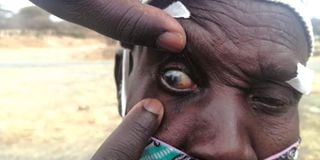Trachoma: Casting an eye over world’s leading cause of preventable blindness

What you need to know:
- Trachoma is caused by infection with the bacterium chlamydia trachomatis.
- Blindness from trachoma is irreversible. The infection spreads through personal contact and by flies.
These days, Ms Namaya Nakwayi, 70, hardly moves anywhere beyond her manyatta in Naitiir village on the outskirts of Kakuma Town, Turkana County.
She spends most of her time sleeping in her manyatta. When someone approaches her compound, the granny supports herself using her hands, moving around her house waiting for the visitor to announce themselves. She then staggers outside. Ms Namaya suffers from trachoma and can barely see past a metre. She’s now at risk of total blindness if her condition isn’t addressed soon.
“My eyes started with an itch. I was initially told it was because of an allergic reaction. I had accompanied my husband to Mogilla (near the border with South Sudan) in search of pasture and water,’’ she narrates through a translator on the onset of her troubled eyesight.
‘‘I was given some drugs in hospital to manage the condition but they made my eyes cloudy. They didn’t work,’’ she recounts, adding that she had to abandon the eye drops. For two years now, Nakwayi has watched with helplessness as her sight faded away.
Her neighbour, Loyelem Loumo, too has been losing her vision gradually, and now can’t see beyond two metres. This woman is taken care of by her granddaughter, a Grade Four pupil at Pokotom Primary School.
Trachoma is caused by infection with the bacterium Chlamydia trachomatis. Blindness from trachoma is irreversible. The infection spreads through personal contact and by flies.
At 25, James Kangolese from Tiaty in the neighbouring Baringo County now depends on people around him for everything: to move around and to feed. His blindness, which also started as trachoma, began in 2011 when he was a Form One student at Kituro High School.
“My eyes had turned red and were very painful and teary. I would also have headaches frequently,’’ he narrates. After two surgical operations and treatment that cost him Sh300,000, the situation didn’t get any better. The young man went blind completely last year.
In this sub-county, prevalence of trachoma among children stands at 12.8 per cent, a drop from 34 percent in 2011. Here, more than 2,000 adults are on the verge of blindness if no urgent interventions are made.
A survey conducted in 2020 in North Pokot and West Pokot shows that trachoma is rife due to the unique relationship between the pastoralists and their animals.
That 37 per cent of the locals practise open defecation complicates efforts to combat the spread of the disease.
Trachoma remains the leading cause infectious cause of preventable blindness worldwide.
The World Health Organization (WHO) says the disease is a public health problem in 44 countries. It’s responsible for the blindness of about 1.9 million people globally. Latest data shows that 137 million people live in trachoma endemic areas with the risk of trachoma blindness.
Turkana, West Pokot, and Baringo counties are some of the endemic areas in Kenya. In Turkana County, Turkana West Sub-county has the highest burden of eye problems due to its high population, the refugee community and harsh climatic conditions.
WHO data shows that 92000 people with trachomatous trichiasis underwent corrective surgery in 2019, while 95.2 million others from trachoma endemic areas were treated for the disease.
But it’s the economic burden associated with the disease that’s more worrying, according to WHO. Blindness and visual impairment cost the country an estimated Sh290 billion and Sh530 billion annually.
Progress has been made, with Lodwar County and Referral Hospital now having a fully-fledged ophthalmic center that provides eye-care services, including through outreach.
Additionally, Turkana County has established a modern eye clinic at Lokitaung in Turkana North Sub County, according to County Health Chief Officer Augustine Lokwang.
This facility, which has two operating theatres is expected to help reduce the number of surgical related referrals and minor ophthalmic ailments to the county referral hospital.
This will serve not only patients in the county but also those from neighboring Uganda, Ethiopia and South Sudan.
The county government’s efforts to combat trachoma are complemented by NGOs in the county, such as Almomin Foundation and International Rescue Committee (IRC) who had organised a free five-day eye clinic for residents of Turkana West Sub County in December last year.
To boost efforts to fight the disease, the county government and the Spanish Eye doctors have entered into partnership dubbed the Turkana Eye Turkana Eye project.
Notably, many patients suffering from eye problems in these counties fail to seek treatment owing to poverty and illiteracy. But misconceptions also abound, with many locals believing that blindness is a result of eye surgery.
One of the areas of focus for the county health department and its partners is to debunk some of these beliefs to encourage people to seek treatment whenever they are experience eye problems.
“Avoidable blindness is among the major health problems in the Sub County with cataract and trachoma being the top causes,” says County Ophthalmic Services Coordinator Dr Samson Dr Lokele.
Report by Fred Kibor, Sammy Lutta, Florah Koech And Oscar Kakai
This report is produced in partnership with the African Investigative Journalism Conference, an initiative of the Journalism Department at the University of Witwatersrand in South Africa, and the Nation Media Group.



